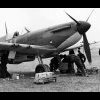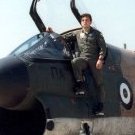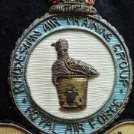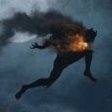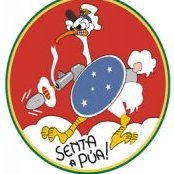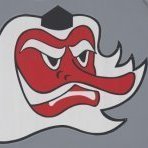-
Posts
281 -
Joined
-
Last visited
-
Days Won
2
Reputation Activity
-

-
 19squadron got a reaction from zaxos345 in 1/32 Tamiya P-51D-5 "Little Eva III"
19squadron got a reaction from zaxos345 in 1/32 Tamiya P-51D-5 "Little Eva III"
This is perfect, very very beautiful, and perfectly judged!
-
 19squadron got a reaction from mozart in Early Spitfire Mk I Armament
19squadron got a reaction from mozart in Early Spitfire Mk I Armament
Hi Paul
yes I read that in some modellers books but I do not think it is correct, - had K5054 been Zinc Chromate treated behind the fuel tank the colour would be even [like the chromate-treated wing I posted], and clearly, individual panels look different, so I think K5054 was natural aluminium in different shades with panels that had oxidised to vary in their appearance.
More importantly the Supermarine records state K5054 was in natural aluminium, and highly polished, so that pretty clearly rules out Zinc Chromate.
-
 19squadron got a reaction from Archimedes in Early Spitfire Mk I Armament
19squadron got a reaction from Archimedes in Early Spitfire Mk I Armament
Doped gun cover patches first appeared on Hawker Hurricanes in 1937, and were painted to match the camouflage of the aircraft.
Spitfires encountered guns freezing at altitude at 19 squadron and 66 squadron tasked with shaking down the new aircraft, with the first guns fitted with MkI flash eliminators.
All manner of remedies were tried starting with removing the eliminators that protruded into the airstream, to the design and issuing of metal clipped gun covers which popped off with the first round, to eventually gun heating piped to each Browning from ducts behind the radiator.
In may 1940 during the Dunkirk operation, aircraft flew with all manner of gun cover provision from metal caps, to rags stuffed into the gun ports. The doping of patches over gun ports was adopted from Hurricane squadrons and initially could be clear dope or the more common red dope, and began to appear during the Dunkirk operation. Elasticated cream coloured sticky backed Medical bandage was also used in may/june 1940, and became the prototype for the bright red sticky slightly elastic gun port cover made for Supermarine and issued from september 1940.
It was routine to also dope newspaper over the cartridge ejector ports during the wet months to stop mud clogging them, there are several fitters accounts of that being routine from pre war.
-
 19squadron got a reaction from Archimedes in Early Spitfire Mk I Armament
19squadron got a reaction from Archimedes in Early Spitfire Mk I Armament
They were linen patches, applied with red dope - simply because those materials were commonly in store at airfields to repair fabric surfaces. Easy cheap and to hand.
Clear dope may have been used, but the evidence is that red dope was common, and that makes sense from the photos and because it was held in stores.
-
 19squadron got a reaction from Archimedes in Early Spitfire Mk I Armament
19squadron got a reaction from Archimedes in Early Spitfire Mk I Armament
Yes absolutely, the point I was trying to make - in reference to your comment about books and gun covers was just how much flawed research there is in the books - sadly! As you know that was an issue I was determined to try to do something about, and got as far as a commission and the first three chapters before it was hijacked. Hey Ho!
-
 19squadron got a reaction from Archimedes in Early Spitfire Mk I Armament
19squadron got a reaction from Archimedes in Early Spitfire Mk I Armament
I am just contemplating doing the same, but from a Tamiya MkXIII in 1/32 which is a much easier start point from the point of view of the basic forms.
-
 19squadron got a reaction from Pete Roberts in Early Spitfire Mk I Armament
19squadron got a reaction from Pete Roberts in Early Spitfire Mk I Armament
They were linen patches, applied with red dope - simply because those materials were commonly in store at airfields to repair fabric surfaces. Easy cheap and to hand.
Clear dope may have been used, but the evidence is that red dope was common, and that makes sense from the photos and because it was held in stores.
-
 19squadron got a reaction from europapete in Early Spitfire Mk I Armament
19squadron got a reaction from europapete in Early Spitfire Mk I Armament
Doped gun cover patches first appeared on Hawker Hurricanes in 1937, and were painted to match the camouflage of the aircraft.
Spitfires encountered guns freezing at altitude at 19 squadron and 66 squadron tasked with shaking down the new aircraft, with the first guns fitted with MkI flash eliminators.
All manner of remedies were tried starting with removing the eliminators that protruded into the airstream, to the design and issuing of metal clipped gun covers which popped off with the first round, to eventually gun heating piped to each Browning from ducts behind the radiator.
In may 1940 during the Dunkirk operation, aircraft flew with all manner of gun cover provision from metal caps, to rags stuffed into the gun ports. The doping of patches over gun ports was adopted from Hurricane squadrons and initially could be clear dope or the more common red dope, and began to appear during the Dunkirk operation. Elasticated cream coloured sticky backed Medical bandage was also used in may/june 1940, and became the prototype for the bright red sticky slightly elastic gun port cover made for Supermarine and issued from september 1940.
It was routine to also dope newspaper over the cartridge ejector ports during the wet months to stop mud clogging them, there are several fitters accounts of that being routine from pre war.
-
 19squadron got a reaction from TAG in Early Spitfire Mk I Armament
19squadron got a reaction from TAG in Early Spitfire Mk I Armament
I never met Edgar Brookes, but we discussed Spitfires online many a time, and crossed swords a couple of times too, particularly over the MkIII oil cooler.
Attached is his take on Gun port patches, recorded in Edgar Brookes's " Spitfire Notes"
The last line in Edgar's notes from above is incorrect.
The date for the Vickers [Supermarine] Issue of "gun port patches" of 24th september 1940 refers to the issuing of factory-made, bright red, sticky-backed, tailored and slightly elastic proprietary cloth gun covers, that took their queue from the elasticated sticky-backed medical bandage used from May 1940 during the Dunkirk emergency.
The Supermarine patches were neat, and instantly applied and their equivalent is readily seen today on flying aircraft, but quite different from the improvised red doped linen patches usually seen in BoB photos and common together with stuffed rag not to mention medical bandage used from May 1940.
-
 19squadron got a reaction from Pete Roberts in Early Spitfire Mk I Armament
19squadron got a reaction from Pete Roberts in Early Spitfire Mk I Armament
And here is a pic showing red dope residue on the wing from patches of the type commonly seen during the BoB, a practice adopted from Hurricane squadrons in May 1940.
-
 19squadron got a reaction from Pete Roberts in Early Spitfire Mk I Armament
19squadron got a reaction from Pete Roberts in Early Spitfire Mk I Armament
With reference to Edgar's last line in the attachment above.
Here is a pic of a Spitfire in 1941 with proprietary Supermarine made sticky back elasticated square gun port patches.
-
 19squadron got a reaction from Pete Roberts in Early Spitfire Mk I Armament
19squadron got a reaction from Pete Roberts in Early Spitfire Mk I Armament
I never met Edgar Brookes, but we discussed Spitfires online many a time, and crossed swords a couple of times too, particularly over the MkIII oil cooler.
Attached is his take on Gun port patches, recorded in Edgar Brookes's " Spitfire Notes"
The last line in Edgar's notes from above is incorrect.
The date for the Vickers [Supermarine] Issue of "gun port patches" of 24th september 1940 refers to the issuing of factory-made, bright red, sticky-backed, tailored and slightly elastic proprietary cloth gun covers, that took their queue from the elasticated sticky-backed medical bandage used from May 1940 during the Dunkirk emergency.
The Supermarine patches were neat, and instantly applied and their equivalent is readily seen today on flying aircraft, but quite different from the improvised red doped linen patches usually seen in BoB photos and common together with stuffed rag not to mention medical bandage used from May 1940.
-
 19squadron got a reaction from dennismcc in Early Spitfire Mk I Armament
19squadron got a reaction from dennismcc in Early Spitfire Mk I Armament
And here is a pic showing red dope residue on the wing from patches of the type commonly seen during the BoB, a practice adopted from Hurricane squadrons in May 1940.
-
 19squadron got a reaction from dennismcc in Early Spitfire Mk I Armament
19squadron got a reaction from dennismcc in Early Spitfire Mk I Armament
With reference to Edgar's last line in the attachment above.
Here is a pic of a Spitfire in 1941 with proprietary Supermarine made sticky back elasticated square gun port patches.
-
 19squadron got a reaction from dennismcc in Early Spitfire Mk I Armament
19squadron got a reaction from dennismcc in Early Spitfire Mk I Armament
I never met Edgar Brookes, but we discussed Spitfires online many a time, and crossed swords a couple of times too, particularly over the MkIII oil cooler.
Attached is his take on Gun port patches, recorded in Edgar Brookes's " Spitfire Notes"
The last line in Edgar's notes from above is incorrect.
The date for the Vickers [Supermarine] Issue of "gun port patches" of 24th september 1940 refers to the issuing of factory-made, bright red, sticky-backed, tailored and slightly elastic proprietary cloth gun covers, that took their queue from the elasticated sticky-backed medical bandage used from May 1940 during the Dunkirk emergency.
The Supermarine patches were neat, and instantly applied and their equivalent is readily seen today on flying aircraft, but quite different from the improvised red doped linen patches usually seen in BoB photos and common together with stuffed rag not to mention medical bandage used from May 1940.
-
 19squadron got a reaction from Kagemusha in Early Spitfire Mk I Armament
19squadron got a reaction from Kagemusha in Early Spitfire Mk I Armament
Doped gun cover patches first appeared on Hawker Hurricanes in 1937, and were painted to match the camouflage of the aircraft.
Spitfires encountered guns freezing at altitude at 19 squadron and 66 squadron tasked with shaking down the new aircraft, with the first guns fitted with MkI flash eliminators.
All manner of remedies were tried starting with removing the eliminators that protruded into the airstream, to the design and issuing of metal clipped gun covers which popped off with the first round, to eventually gun heating piped to each Browning from ducts behind the radiator.
In may 1940 during the Dunkirk operation, aircraft flew with all manner of gun cover provision from metal caps, to rags stuffed into the gun ports. The doping of patches over gun ports was adopted from Hurricane squadrons and initially could be clear dope or the more common red dope, and began to appear during the Dunkirk operation. Elasticated cream coloured sticky backed Medical bandage was also used in may/june 1940, and became the prototype for the bright red sticky slightly elastic gun port cover made for Supermarine and issued from september 1940.
It was routine to also dope newspaper over the cartridge ejector ports during the wet months to stop mud clogging them, there are several fitters accounts of that being routine from pre war.
-
 19squadron reacted to Pete Roberts in Early Spitfire Mk I Armament
19squadron reacted to Pete Roberts in Early Spitfire Mk I Armament
Why not still go ahead with your own book on the Spitfire? You could always self publish (?)
PS - I’d be in line for a copy!
-
 19squadron got a reaction from Pete Roberts in Early Spitfire Mk I Armament
19squadron got a reaction from Pete Roberts in Early Spitfire Mk I Armament
Here is a pic of a Spitfire wing having undergone Zinc Chromate coating as an assembly, note the even colour.
-
 19squadron got a reaction from Pete Roberts in Early Spitfire Mk I Armament
19squadron got a reaction from Pete Roberts in Early Spitfire Mk I Armament
Ally panels on K5054 after her first flight. It is not normal to chromate ally sheet before it is cut and formed, because the coating gets damaged. Normal practice is to coat assemblies once they are completed but before assembly.
-
 19squadron got a reaction from Pete Roberts in Early Spitfire Mk I Armament
19squadron got a reaction from Pete Roberts in Early Spitfire Mk I Armament
Most publications are very inadequate on the subject, by far the best way to understand what went on is to speak with RAF fitters who served in Fighter Command squadrons during 1940.
Of all the books on the Spitfire, I cannot think of one that has not printed a misrepresentation, with the sole exceptions of Alfred Price's books which are excellent and also Cyril Russell's book, Spitfire Odessy which is again excellent.
Just take K5054 as an example -
In the On Target profile no 4 K5054 is drawn with production Spitfire panel lines - totally wrong, but does present K5054 in it's second paint scheme [sky blue] with roundels with white borders, which is correct.
Contrast that to the scheme below, with some of the correct panel lines [but not all] but showing highly unlikely coloured Zinc chromate surfaces.
-
 19squadron got a reaction from Pete Roberts in Early Spitfire Mk I Armament
19squadron got a reaction from Pete Roberts in Early Spitfire Mk I Armament
Doped gun cover patches first appeared on Hawker Hurricanes in 1937, and were painted to match the camouflage of the aircraft.
Spitfires encountered guns freezing at altitude at 19 squadron and 66 squadron tasked with shaking down the new aircraft, with the first guns fitted with MkI flash eliminators.
All manner of remedies were tried starting with removing the eliminators that protruded into the airstream, to the design and issuing of metal clipped gun covers which popped off with the first round, to eventually gun heating piped to each Browning from ducts behind the radiator.
In may 1940 during the Dunkirk operation, aircraft flew with all manner of gun cover provision from metal caps, to rags stuffed into the gun ports. The doping of patches over gun ports was adopted from Hurricane squadrons and initially could be clear dope or the more common red dope, and began to appear during the Dunkirk operation. Elasticated cream coloured sticky backed Medical bandage was also used in may/june 1940, and became the prototype for the bright red sticky slightly elastic gun port cover made for Supermarine and issued from september 1940.
It was routine to also dope newspaper over the cartridge ejector ports during the wet months to stop mud clogging them, there are several fitters accounts of that being routine from pre war.
-
 19squadron got a reaction from Tolga ULGUR in Early Spitfire Mk I Armament
19squadron got a reaction from Tolga ULGUR in Early Spitfire Mk I Armament
Doped gun cover patches first appeared on Hawker Hurricanes in 1937, and were painted to match the camouflage of the aircraft.
Spitfires encountered guns freezing at altitude at 19 squadron and 66 squadron tasked with shaking down the new aircraft, with the first guns fitted with MkI flash eliminators.
All manner of remedies were tried starting with removing the eliminators that protruded into the airstream, to the design and issuing of metal clipped gun covers which popped off with the first round, to eventually gun heating piped to each Browning from ducts behind the radiator.
In may 1940 during the Dunkirk operation, aircraft flew with all manner of gun cover provision from metal caps, to rags stuffed into the gun ports. The doping of patches over gun ports was adopted from Hurricane squadrons and initially could be clear dope or the more common red dope, and began to appear during the Dunkirk operation. Elasticated cream coloured sticky backed Medical bandage was also used in may/june 1940, and became the prototype for the bright red sticky slightly elastic gun port cover made for Supermarine and issued from september 1940.
It was routine to also dope newspaper over the cartridge ejector ports during the wet months to stop mud clogging them, there are several fitters accounts of that being routine from pre war.
-
 19squadron got a reaction from Tolga ULGUR in Early Spitfire Mk I Armament
19squadron got a reaction from Tolga ULGUR in Early Spitfire Mk I Armament
Here is a pic of a Spitfire wing having undergone Zinc Chromate coating as an assembly, note the even colour.
-
 19squadron got a reaction from Tolga ULGUR in Early Spitfire Mk I Armament
19squadron got a reaction from Tolga ULGUR in Early Spitfire Mk I Armament
Ally panels on K5054 after her first flight. It is not normal to chromate ally sheet before it is cut and formed, because the coating gets damaged. Normal practice is to coat assemblies once they are completed but before assembly.


